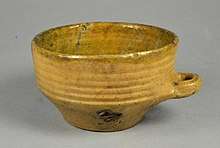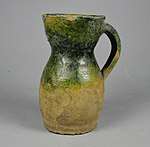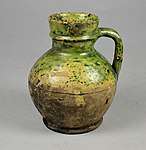Border ware
Border ware is a type of post-medieval British pottery commonly used in London during the sixteenth and seventeenth centuries. The lead-glazed, sandy earthenware was produced from kilns along the border between Hampshire and Surrey. There are two classes of Border ware, fine whitewares and fine redwares.

History
Border ware evolved from a medieval pottery known as Surrey whiteware. Surrey whiteware consisted of four classes: Kingston-type ware, Coarse Border ware, Cheam whiteware and Tudor Green ware. The earlier whitewares were produced from the 13th to the 16th centuries.[1][2]
Border ware was manufactured in the Surrey-Hampshire border area from the 16th century to the 19th centuries, although the whitewares were produced only during the sixteenth and seventeenth centuries. The demand for whitewares declined during the 17th century while the demand for redwares increased..[3] The production of whitewares ended most likely during the early 18th century; Redwares continued to be produced until the 19th century.[4]
Description

The term, "Border ware" was introduced by archaeologist, Clive Orton, to describe the lead-glazed, sandy earthenware produced along the Surrey-Hampshire borders during the early post-medieval period. The pottery is divided into two classes, whitewares and redwares, although the term "Border ware" generally refers to the whitewares. The redwares are known as "Red Border ware.[4]
Fabrics
Whiteware fabrics are generally hard with a smooth and fine texture. Fabric colours include off-white, yellow, brown, buff, olive and pinkish grey. Glazes are often crazed and finishes range from thin and spotty to thick and glossy. Glaze colours include yellow, brown, olive clear, and green.[5]
Redware fabrics range from smooth to slightly rough in feel. Fabric colours generally range from brick red to reddish-yellow. Finishes range from thin and uneven to thick and glossy. A clear lead glaze was often used, giving the pottery products an orange or reddish-brown colour. Other glaze colours include olive, brown and green. Green glaze was created by potters by adding copper to lead glaze.[6]
Forms
Pottery products were traditional household items commonly used during the post-medieval period.[7] Skillets, saucepans, chafing dishes and tripod pipkins were common cookware products manufactured by the Border ware pottery industry.

Border ware forms used for serving and storing food begin with dishes, which are divided into flanged dishes and deep dishes. Bowls were manufactured in a wide variety of shapes and sizes: wide bowls, deep bowls, bowls with handles, and porringers. Vessels for storing and serving liquids include drinking jugs, cups, goblets and mugs.
Other Border ware forms include costrels (portable flasks), which can be divided into two categories, mammiform costrels and bottle shaped costrels. Candlesticks were two styles: upright and saucer. There were also lanterns, chamber pots, money boxes, jars, double dishes, whistles, fuming pots and strainers.
Production
— F.W. Holling, 1971.[8]
Clay Sources
The source of the white-firing clays used to produce Surrey whitewares was the Reading Beds along the borders of Hampshire and Berkshire. The Reading beds between Farnham and Tongham were the best source of potting clay for medieval potters producing wares for the London market. These outcrops of white-firing and red-firing clay deposits had provided an abundant source of clays for pottery manufacturing since the early Roman period.[9]
Pottery sites
Border ware manufacturing sites were selected for their proximity to plentiful clay and fuel supplies.[10] The area northeast of Farnham became the centre of the Border ware pottery industry. Three sites have been identified as producing the pottery best representing Border Ware fabrics, forms and glazes. These sites are: Farnborough Hill Convent in Farnborough, Hampshire, Ye Old Malthouse in Hawley, Hampshire and The Lime, Ash, Surrey.[11]
Gallery
 Border ware jar
Border ware jar Border ware candlestick
Border ware candlestick Border ware bowl
Border ware bowl Border ware jug
Border ware jug Border ware pipkin
Border ware pipkin Border ware jug
Border ware jug
Notes
- Vince 1985, p. 76.
- Pearce & Vince 1988, p. 7.
- Holling 1971, p. 64.
- Pearce 1992, p. 1.
- Pearce 1992, p. 5.
- Pearce 1992, p. 6.
- Holling 1971, p. 69.
- Holling 1971, p. 65.
- Pearce 1992, p. 3.
- Holling 1971, p. 63.
- Pearce 1992, p. 2.
References
- Holling, F.W. (1971). "A preliminary note on the pottery industry of the Hampshire-Surrey Borders". Surrey Archaeological Collections. 68: 57–88. Retrieved 4 April 2020.
- Pearce, Jaqueline; Vince, Alan (1988). Surrey Whitewares. London: London & Middlesex Archaeological societies. ISBN 978-0903290340.
- Pearce, Jaqueline (1992). Border Wares. Post-Medieval Pottery in London 1500-1700. London: Museum of London. ISBN 978-0112904946.
- Vince, A.G. (1985). "The Saxon and Medieval Pottery of London: A Review" (PDF). Journal of Medieval Archaeology. 29: 29–83. Retrieved 4 April 2020.
Further reading
- Laing, Lloyd (2003). Pottery in Britain 4000 BC to AD 1900. Greenlight Publishing. ISBN 978-1897738146.
- McCarthy, Michael; Brooks, Catherine M. (1995). Medieval Pottery in Britain, Ad 900-1600. Leicester University Press. ISBN 978-0718512712.